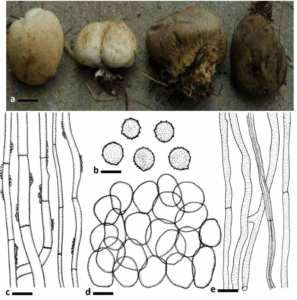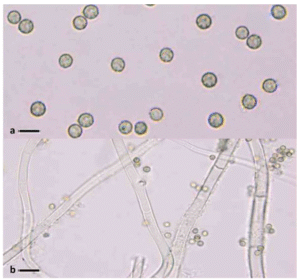Lycoperdon pseudocurtisii Yousaf & Khalid, sp. nov.
Index Fungorum number: IF 556120; MycoBank number: MB 556120; Facesoffungi number: FoF 05751; Figs. 73, 74
Etymology: Named after the resemblence with L. curtisii.
Holotype: LAH100000150.
Basidiocarps subglobose, 10–25 mm diam, × 25 mm in height, off-white when young, turning grey with age; attached to the substratum by a small mycelial pad, heavily encrusted with particles of soil; dehiscence is by an apical pore or slit, pore develops with sloughing of exoperidium, up to 5 mm diam. Exoperidium off-white, granular, floccose with rubbery texture, not persistent, sloughed off in mature specimens, not in the form of patches or plates. Endoperidium papery, greyish brown. Gleba olivaceous, cottony. Diaphragm distinct. Subgleba present, comprising 1/3rd of basidiocarps. Basidiospores asperulate, globose, olivaceous, 2.8–3.8 µm diam. Eucapillitium absent. Paracapillitium abundant, hyaline, septate, encrusted with some amorphous material, 3.0–7.5 µm idiam, thin-walled, branched. Exoperidium composed of hyaline, subglobose to elongated, thin-walled hyphal sphaerocysts. Endoperidium composed of tightly interwoven, hyaline to light brown, thick-walled, septae, up to 5 µm diam, branched hyphae.
Material examined: PAKISTAN, Punjab, Lahore, University of the Punjab, New Campus, 25 July, 2013, under Grevillea robusta A.Cunn. ex R.Br., in groups, among grass, at 217 m (712 ft.) a.s.l., N. Yousaf, VPK3 (LAH100000150, holotype).
GenBank numbers: ITS: MK414503, MK414504, MK414505.
Notes: Lycoperdon pseudocurtisii (VPK3) is characterized by off-white basidiocarps, up to 25 mm diam, distinct diaphragm, asperulate, globose basidiospores (2.8–3.8 µm), absence of eucapillitium, abundant paracapillitium and thick-walled endoperidial hyphae. Phylogenetically L. pseudocurtisii is close to V. curtisii. Both of these taxa have globose asperulate basidiospores but the presence of eucapillitium and an indistinct diaphragm are features of V. curtisii not found in L. pseudocurtisii. V. hyalinum and V. intermedium are closely related taxa because they share the characters of a distinct diaphragm, globose to subglobose asperulate basidiospores and the absence of a eucapillitium. The exoperidium peels away in patches or plates in these taxa but this character is absent in L. pseudocurtisii. Basidiospores in the latter are smaller compared to the larger basidiospores of both taxa.

Fig. 73 Lycoperdon pseudocurtisii (VPK3, holotype). a Basidiocarps. b Asperulate basidiospores. c Paracapillitial hyphae. d Exoperidial elements. e Endoperidial hyphae. Scale bars: a = 5 mm, b = 2.5 µm, c, d, e = 10 µm

Fig. 74 Lycoperdon pseudocurtisii (VPK3, holotype). a Light micrograph of asperulate basidiospores. b Light Micrograph of paracapillitial hyphae. Scale bars: a = 6 µm, b = 8 µm
